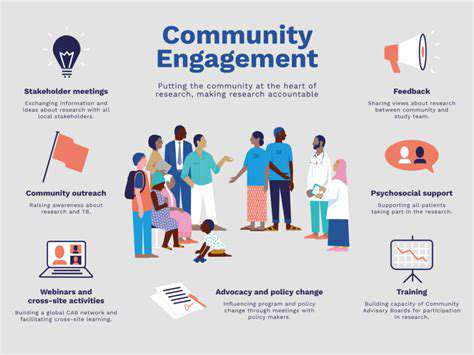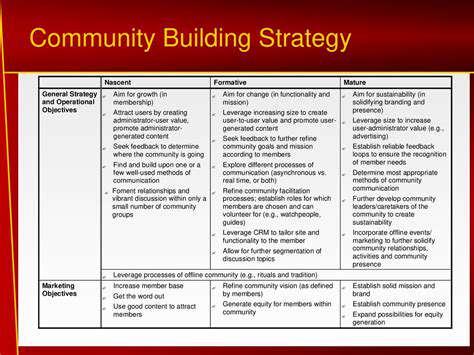Content Syndication: Expanding Your Content's Footprint
Choosing the Right Syndication Channels
Optimizing for Specific Platforms
Different syndication platforms cater to distinct audiences and purposes. Understanding the nuances of each platform is crucial for maximizing your content's reach and impact. For example, a blog post aimed at a younger demographic might perform better on platforms like TikTok or Instagram, where visual content is prioritized. Conversely, a detailed research report might be more effectively syndicated on academic or industry-focused platforms. Careful consideration of the platform's user base and content style is essential for optimizing your syndication strategy.
Tailoring your content to the specific platform's format and expectations is also key. This includes adhering to character limits, image requirements, and any other specific guidelines. For instance, LinkedIn articles often perform better with concise summaries and clear calls to action, while longer-form content might be better suited for platforms like Medium or a company blog. Adapting your content to the platform's style will ensure your message resonates with the target audience and increases engagement.
Considering Your Audience Reach
A key aspect of effective content syndication is understanding where your target audience hangs out online. Identifying the specific platforms and websites where your ideal customers or clients are most active is essential for maximizing your impact. If your target demographic is heavily engaged on Twitter, syndicating your content there will likely yield better results than trying to reach them on a platform they rarely use. Conducting thorough research into your audience's online habits is a crucial step in your syndication strategy.
Analyzing website traffic and social media engagement data can provide valuable insights into audience preferences. Tracking which platforms generate the most organic reach, comments, and shares will help you understand where your content resonates most effectively. By focusing on platforms where your audience is already active, you can increase the likelihood of your content being seen by the right people and achieving your desired outcomes.
Leveraging Content Formats
Content syndication isn't just about posting the same content across various platforms; it's about adapting your approach to each platform's unique strengths. Consider whether your content is best suited for a short-form video, a long-form blog post, an infographic, or an interactive tool. Understanding the format that aligns best with each platform's capabilities is essential for maximizing engagement and impact. A humorous video clip might perform exceptionally on platforms like Instagram Reels, whereas a detailed infographic might be better suited for Pinterest.
Adapting your content format can significantly boost your reach. For instance, a blog post could be transformed into a series of shorter tweets, a set of engaging Instagram stories, or a compelling LinkedIn article. Thinking creatively about how to repackage your content for different platforms can significantly broaden your audience and create more opportunities for engagement.
Measuring the ROI of Syndication
Implementing a robust tracking system for your syndicated content is paramount for measuring its effectiveness. Use analytics tools to monitor key metrics such as impressions, clicks, shares, and conversions. By tracking these metrics across various platforms, you can gain valuable insights into which syndication strategies are most successful in driving engagement and achieving your desired business outcomes. This data will help you refine your approach and identify areas for improvement.
Regularly analyzing the performance of your syndicated content is critical for optimizing your strategy over time. By understanding which platforms and formats are delivering the best results, you can prioritize your efforts accordingly and focus on those channels that provide the highest return on investment. This data-driven approach will help you fine-tune your content syndication strategy and ensure that your content is reaching the right audience and achieving its intended goals.
Choosing the Right Tools
There are several tools and platforms designed to streamline the process of content syndication. Some tools allow you to schedule posts across multiple platforms, track performance metrics, and analyze audience engagement. Selecting the right tool or combination of tools can significantly simplify your workflow and free up your time for other strategic initiatives. A well-chosen tool can significantly enhance your content syndication efforts by automating tasks and providing valuable insights.
Tools that offer features like automated scheduling, social media analytics, and content repurposing capabilities can help you efficiently manage your syndication efforts. Consider the specific functionalities you need and choose a tool that aligns with your workflow and business goals. By utilizing the right tools, you can effectively manage your content syndication and ensure a more efficient and effective process.
Measuring the Impact of Your Syndication Efforts
Understanding Your Baseline
Before launching any syndication campaign, it's crucial to establish a clear understanding of your current website traffic, social media engagement, and overall online presence. This baseline serves as a critical benchmark against which you can measure the effectiveness of your syndication efforts. Analyzing existing data points, such as unique visitors, page views, and conversion rates, provides valuable insights into your current performance and helps you set realistic goals for future growth.
Tracking key metrics like website traffic, social media reach, and lead generation before syndication will allow for a more accurate assessment of the impact. This baseline data will form the foundation for evaluating the success of your syndication strategy.
Identifying Relevant Syndication Platforms
Not all syndication platforms are created equal. Careful consideration must be given to the specific audience and goals of your content. Researching and selecting platforms that align with your target audience, brand identity, and content pillars is essential for maximizing the impact of your syndication efforts. Consider factors like platform demographics, engagement rates, and potential reach when making your selection.
Evaluating the target audience and content compatibility of different syndication platforms will help you make informed decisions. A platform that doesn't reach your ideal audience will not yield the results you're looking for.
Monitoring Key Performance Indicators (KPIs)
Establishing clear and measurable KPIs is essential for tracking the success of your syndication efforts. Tracking website traffic from syndicated content, social media engagement, and lead generation are all vital metrics to monitor. Using analytics platforms to monitor these KPIs will provide insights into the effectiveness of your syndication strategy.
Regularly monitoring these KPIs allows you to identify which syndication platforms and content types are performing best. This data-driven approach will help you optimize your strategy for maximum impact and ROI.
Analyzing Traffic Sources and Referral Patterns
Diving deeper into website analytics, specifically focusing on traffic sources, is crucial. Identifying which syndication platforms are driving the most valuable traffic to your website is essential for optimizing your strategy. Examining referral patterns allows you to understand which specific pieces of content resonate most strongly with the target audience on external platforms, which in turn helps refine future syndication efforts.
Evaluating Content Performance on Syndicated Platforms
Assessing the performance of your content on syndicated platforms is vital for understanding its impact. Analyzing metrics like click-through rates, engagement rates, and social shares provides a clear picture of how your content is performing in new environments. This information allows you to identify which topics and formats resonate best with different audiences, enabling you to tailor future content creation for optimal results.
Tracking content performance on syndicated platforms is essential. Monitoring factors such as the average time spent on the page and the bounce rate will yield valuable insights into audience engagement.
Measuring the Impact on Lead Generation and Conversions
A significant goal of content syndication is often lead generation and conversions. Tracking the number of leads generated through syndicated content and the conversion rates associated with these leads provides a direct measure of the impact on your business objectives. Analyzing the correlation between syndication efforts and sales or new customer acquisition is crucial for understanding the ROI of your strategy.
Conversion tracking and lead nurturing are critical aspects to measure the return on investment (ROI) of your content syndication efforts. A comprehensive analysis of these metrics will provide a clear picture of the effectiveness of your strategy in achieving business goals.
Read more about Content Syndication: Expanding Your Content's Footprint
Hot Recommendations
- Attribution Modeling in Google Analytics: Credit Where It's Due
- Understanding Statistical Significance in A/B Testing
- Future Proofing Your Brand in the Digital Landscape
- Measuring CTV Ad Performance: Key Metrics
- Negative Keywords: Preventing Wasted Ad Spend
- Building Local Citations: Essential for Local SEO
- Responsive Design for Mobile Devices: A Practical Guide
- Mobile First Web Design: Ensuring a Seamless User Experience
- Understanding Your Competitors' Digital Marketing Strategies
- Google Display Network: Reaching a Broader Audience











